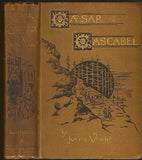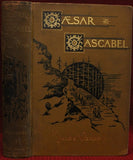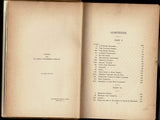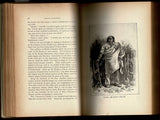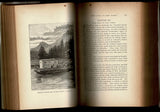Cæsar (Caesar) Cascabel
Author: Jules Gabriel Verne (1828-1905)
Year: 1890
Publisher: Cassell Publishing Company
Place: New York
Description:
iv+373 pages with eighty-one plates including frontispiece. Octavo (8 1/2" x 6") bound in the variant mustard cloth with spine and cover lettering in gilt and black pictorial on spine and cover. Translated from the French by A Estoclet. Illustrations by George Roux. (Gallagher, Mistichelli and Van Eerde: A69) First American edition preceding the English edition.
Jules Gabriel Verne was a French novelist, poet, and playwright best known for his adventure novels and his profound influence on the literary genre of science fiction. Verne was born to bourgeois parents in the seaport of Nantes, where he was trained to follow in his father's footsteps as a lawyer, but quit the profession early in life to write for magazines and the stage. His collaboration with the publisher Pierre-Jules Hetzel led to the creation of the Voyages Extraordinaires, a widely popular series of scrupulously researched adventure novels including Journey to the Center of the Earth, Twenty Thousand Leagues Under the Sea, and Around the World in Eighty Days. Verne is generally considered a major literary author in France and most of Europe, where he has had a wide influence on the literary avant-garde and on surrealism. His reputation is markedly different in Anglophone regions, where he has often been labeled a writer of genre fiction or children's books, not least because of the highly abridged and altered translations in which his novels are often reprinted. Verne has been the second most-translated author in the world since 1979, between the English-language writers Agatha Christie and William Shakespeare, and probably was the most-translated during the 1960s and 1970s. He is one of the authors sometimes called "The Father of Science Fiction", as are H. G. Wells and Hugo Gernsback.
Caesar Cascabel recounts the journey of the travelling circus of the Cascabel family, from Sacramento as far as European Russia, while passing by Canada, Alaska, the Strait of Behring and Siberia. The head of the Cascabel household had to start this perilous voyage after the money intended to pay the tickets of the boat, which was to take them along to France from New York, was stolen by thieves. So, Caesar crosses initially the vast forests of Canada. At the border of Alaska, they save the life of Mr Jean, a banished Russian aristocrat who had been just attacked by outlaws. They also make the acquaintance on this occasion of Kayette, a young Indian woman, who had also dashed for the noble Russian. After having waited a few weeks that the Strait of Behring freezes, all the family finally thrusts upon the sea of ice but, in the medium of the crossing, the temperature of the air increases dangerously and the ice is parceled out. The caravan of the Cascabels is detached soon from the ice-barrier on an iceberg and our heroes start to drift across the Arctic Ocean. When the Cascabels finally manage to reach the northern coast of Siberia, they are made prisoners by a local tribe who requires from them a ransom for their release that they cannot obviously provide. Next spring, Cesar Cascabel, by using its gift of ventriloquy, frightens the chief of the tribe and manages to obtain his release. The Cascabel company, meanwhile, increased its numbers with two Russian sailors who were also prisoners. These sailors are in fact the two brigands who had attacked Mr Jean in the Canadian forest. They now envisage to rob Cascabel, with the assistance of accomplices, when the company is crossing the chain of the Ural. Meanwhile, Jean and Kayette fall in love and see with anxiety come the time of the separation.
Condition:
Corners gently bumped, light age toning to preliminary pages, some internal fingering, end paper renewed, spine darkened else a very good copy.
Year: 1890
Publisher: Cassell Publishing Company
Place: New York
Description:
iv+373 pages with eighty-one plates including frontispiece. Octavo (8 1/2" x 6") bound in the variant mustard cloth with spine and cover lettering in gilt and black pictorial on spine and cover. Translated from the French by A Estoclet. Illustrations by George Roux. (Gallagher, Mistichelli and Van Eerde: A69) First American edition preceding the English edition.
Jules Gabriel Verne was a French novelist, poet, and playwright best known for his adventure novels and his profound influence on the literary genre of science fiction. Verne was born to bourgeois parents in the seaport of Nantes, where he was trained to follow in his father's footsteps as a lawyer, but quit the profession early in life to write for magazines and the stage. His collaboration with the publisher Pierre-Jules Hetzel led to the creation of the Voyages Extraordinaires, a widely popular series of scrupulously researched adventure novels including Journey to the Center of the Earth, Twenty Thousand Leagues Under the Sea, and Around the World in Eighty Days. Verne is generally considered a major literary author in France and most of Europe, where he has had a wide influence on the literary avant-garde and on surrealism. His reputation is markedly different in Anglophone regions, where he has often been labeled a writer of genre fiction or children's books, not least because of the highly abridged and altered translations in which his novels are often reprinted. Verne has been the second most-translated author in the world since 1979, between the English-language writers Agatha Christie and William Shakespeare, and probably was the most-translated during the 1960s and 1970s. He is one of the authors sometimes called "The Father of Science Fiction", as are H. G. Wells and Hugo Gernsback.
Caesar Cascabel recounts the journey of the travelling circus of the Cascabel family, from Sacramento as far as European Russia, while passing by Canada, Alaska, the Strait of Behring and Siberia. The head of the Cascabel household had to start this perilous voyage after the money intended to pay the tickets of the boat, which was to take them along to France from New York, was stolen by thieves. So, Caesar crosses initially the vast forests of Canada. At the border of Alaska, they save the life of Mr Jean, a banished Russian aristocrat who had been just attacked by outlaws. They also make the acquaintance on this occasion of Kayette, a young Indian woman, who had also dashed for the noble Russian. After having waited a few weeks that the Strait of Behring freezes, all the family finally thrusts upon the sea of ice but, in the medium of the crossing, the temperature of the air increases dangerously and the ice is parceled out. The caravan of the Cascabels is detached soon from the ice-barrier on an iceberg and our heroes start to drift across the Arctic Ocean. When the Cascabels finally manage to reach the northern coast of Siberia, they are made prisoners by a local tribe who requires from them a ransom for their release that they cannot obviously provide. Next spring, Cesar Cascabel, by using its gift of ventriloquy, frightens the chief of the tribe and manages to obtain his release. The Cascabel company, meanwhile, increased its numbers with two Russian sailors who were also prisoners. These sailors are in fact the two brigands who had attacked Mr Jean in the Canadian forest. They now envisage to rob Cascabel, with the assistance of accomplices, when the company is crossing the chain of the Ural. Meanwhile, Jean and Kayette fall in love and see with anxiety come the time of the separation.
Condition:
Corners gently bumped, light age toning to preliminary pages, some internal fingering, end paper renewed, spine darkened else a very good copy.









